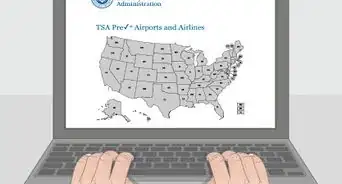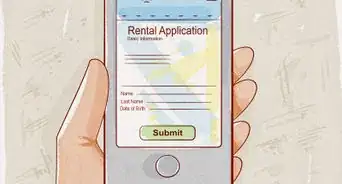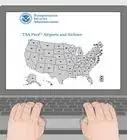This article was co-authored by Clinton M. Sandvick, JD, PhD. Clinton M. Sandvick worked as a civil litigator in California for over 7 years. He received his JD from the University of Wisconsin-Madison in 1998 and his PhD in American History from the University of Oregon in 2013.
There are 16 references cited in this article, which can be found at the bottom of the page.
This article has been viewed 60,718 times.
It could be your worst nightmare: you apply for your dream job only to find out that a negative background check is costing you the job. But what happens if the information in the background check is wrong? Background checks gather information from a variety of sources, including credit reporting agencies and criminal history records. If there is a mistake in your background check, then your first step is to lodge a dispute with the background screening company. If there are errors in your credit reports or criminal history records, then you will need to go ahead and raise your dispute with the organization that maintains those records.
Steps
Finding Errors
-
1Receive a copy of your background report. If an employer finds something in your background check which might cause them not to hire you, then federal law requires that you be given a copy of your background report. They must give it to you before taking the “adverse action,” i.e., not hiring you.[1]
- You will also receive an explanation of your rights under the law.
-
2Read the report for errors. You should go through the report carefully and find any mistakes that you want to challenge. It will be easier to dispute all errors at once, so be sure to find all of them.
- Take out a highlighter and identify the inaccurate information by highlighting it. If you want to make a notation, then use a sticky note.
Advertisement -
3Look for common errors. Unfortunately, mistakes are not uncommon with background checks. Background screening companies make several errors, including the following:[2]
- mismatch you with someone who has a similar name
- report arrests but do not report that no charges were filed
- reveal information that was sealed or expunged
- list a single criminal charge multiple times
- classify misdemeanor offenses as felonies
-
4Identify the source of the error. A background check can consist of many different types of information. Usually a background screening company gathers the information from many different sources. Background checks can include:
- driving records
- criminal history
- military records
- educational history
- past employment
- credit records
Filing a Dispute with a Screening Company
-
1Contact the background screening company. The employer is obligated to give you the name, address, and telephone number of the company that performed the background screening check. If you are trying to correct the background information before an employer makes a final decision about a job, then you don’t want to delay.
- Each screening company has its own dispute process. However, each should investigate the mistake promptly.
- There should be no charge for the reinvestigation.[3]
-
2Complete a dispute form. The background screening company might have a dispute form that you must fill out. The form will typically ask for:[4]
- your contact and identifying information
- the information you are disputing
- the address you want the investigation results sent to
-
3Wait for the results. Under federal law, background screening companies have 30 days to reinvestigate.[5]
- If the background screening company reported the information wrong, then it should fix your report.
- However, the background screening company might not have made a mistake. Instead, the error could be on your credit report or in public records, such as your criminal history report. In order to fix those errors, you need to lodge a dispute with the credit reporting agency or with the appropriate public agency.
-
4Complain to the Federal Trade Commission. The background screening company might refuse to investigate or refuse to correct its errors. In this situation, you can complaint to the Federal Trade Commission (FTC). The FTC has the power to investigate and fine these companies for failing to comply with the law.
- To reach the FTC, visit www.ftc.gov or call 1-877-382-4357.
Disputing Erroneous Credit Information
-
1Write a letter. You should dispute erroneous information on your credit report by contacting the credit reporting agency (CRA) which is reporting the information. You can write them a letter. If the false information is on the credit reports of all three CRAs, then write all three. Be sure to include the following information in your letter:[6]
- Your personal information (name, address, date of birth and Social Security Number).
- The entries which you believe are not accurate. Explain why the information is inaccurate.
- Your request that the CRA delete or revise the information.
-
2Send the letter. You should mail the letter to the CRA by certified mail, return receipt requested. Save the receipt since it is proof that the agency received your letter. Mail your letter to the following addresses:
-
3Report erroneous information online. Most CRAs prefer that you dispute inaccurate information using their online system. You can certainly do so (though you should still send a letter, since the letter is tangible proof that you have reported the error).
- You can reach Equifax’s online dispute system by visiting its website and clicking the “Credit Report Assistance” tab near the top of the page. Then select “Dispute info on credit report” and provide requested information.
- You can reach Experian’s online dispute system by visiting its website and then clicking on “Disputes” under the “Consumer Assistance” heading.[9]
- You can reach TransUnion’s online dispute system by visiting its website and then clicking on the “Credit Report Assistance” tab, which can be found at the top of the page.[10]
-
4Wait to hear back from the CRA. Generally, the credit reporting agency must investigate the details of your dispute within 30 days.[11] As part of the investigation, the CRA forwards your information to the creditor which reported the challenged information.[12]
- After being contacted by the CRA, the creditor will investigate and report back. If the creditor made a mistake, then it notifies all national credit reporting agencies.[13]
- At the close of the investigation, the CRA sends you the results of the investigation. It will also send you the names, addresses, and phone numbers of any creditor which reported erroneous information.
-
5Include a statement of dispute, if necessary. The CRA might decide that the information is accurate. In this situation, your only course of action is to ask to include a “statement of dispute.” Any statement you add gets included in future reports.[14]
- You can also pay a fee to have the CRA forward your statement of dispute to anyone who has recently requested a copy of your credit report.[15]
- You should think carefully before adding a statement of dispute. A statement can help if you have a solid reason why you fell behind on credit payments, such as medical problems which consumed all of your time and money.
- Some experts recommend that you should never include a statement of dispute since this validates the challenged information. Also, divulging medical problems might make employers and others see you as a bad risk.
Correcting Public Records
-
1Find your state Bureau of Identification. If you want to dispute errors in your criminal history records, then you need to contact the appropriate state office. This agency goes by different names, depending on the state: the Bureau of Criminal Investigation, the Department of Justice, the Bureau of Identification, etc.[16] [17] [18]
- In some states, you may have to contact the court where the criminal information was filed. In this situation, you can find the court’s contact information on the Internet.
-
2File a challenge to the record. You should contact the relevant state agency to challenge a criminal record. Typically, you can call or mail a challenge. Be sure to have the following information available:[19]
- the particular record you believe is inaccurate
- how you want the record corrected
- your justifications for the correction
-
3Wait for the results. The state agency should investigate your request. If the agency agrees, it should correct the record.
- If the agency disagrees with you, then you should ask about what steps you should take next. In some states, you might have to petition the Superior Court to have the record changed.[20]
-
4Contact the court about civil actions. Records might exist which falsely show that you were sued by someone. In order to correct this information, you need to contact the courthouse where the record was filed.[21] [22]
- To find the contact number, you can search on the Internet. The background screening report should state where you were sued. Type the county and state and “courthouse” in order to find the phone number.
- Call and state that you want to correct erroneous court records. You should have the year of the case (and the case name, if available). Each courthouse will handle the dispute process differently.
References
- ↑ https://privacyrights.org/consumer-guides/employment-background-checks-jobseekers-guide
- ↑ http://blogs.findlaw.com/law_and_life/2015/04/how-to-fix-errors-on-a-background-check.html
- ↑ https://www.acheckglobal.com/services/adverse-letters-and-applicant-disputes.aspx
- ↑ https://ows01.hireright.com/consumer_request/0.do;jsessionid=DAC1DA0A55516EB638ADE4ECCEFB2352?event=DEFAULT&create=true&_ga=1.75446231.497403549.1454339499
- ↑ http://www.aboutemployeebackgroundchecks.com/can-i-dispute-the-results-of-my-employment-background-check/
- ↑ http://www.consumer.ftc.gov/articles/0151-disputing-errors-credit-reports
- ↑ http://www.experian.com/disputes/how-to-dispute.html
- ↑ https://www.transunion.com/credit-disputes/credit-disputes-faq
- ↑ http://www.experian.com/disputes/main.html
- ↑ http://www.transunion.com/
- ↑ http://blog.equifax.com/credit/how-to-dispute-credit-report-errors/#
- ↑ http://www.consumer.ftc.gov/articles/0151-disputing-errors-credit-reports
- ↑ http://www.consumer.ftc.gov/articles/0151-disputing-errors-credit-reports
- ↑ http://www.consumer.ftc.gov/articles/0151-disputing-errors-credit-reports
- ↑ http://www.consumer.ftc.gov/articles/0151-disputing-errors-credit-reports
- ↑ http://www.backgroundreport.com/disputes/ohio
- ↑ http://www.backgroundreport.com/disputes/montana
- ↑ http://www.backgroundreport.com/disputes/maine
- ↑ http://www.maine.gov/dps/Sbi/challenge.html
- ↑ http://www.maine.gov/dps/Sbi/challenge.html
- ↑ http://www.backgroundreport.com/disputes/maine
- ↑ http://www.backgroundreport.com/disputes/texas
About This Article
If your background check contains false information, you’ll need to dispute it with the screening company. Many screening companies have online or paper dispute forms you can fill in, but otherwise you should call the company. It might be that the error is with a credit reporting agency or public agency. If this is the case, you’ll need to contact the agency directly. If the error is with a credit reporting agency, dispute the false information through their online system or send them a letter. If the mistake is with your state bureau of Identification, call or mail them instead. If a screening company refuse to investigate or correct errors with their own system, file a complaint with the Federal Trade Commission. For more tips from our Legal co-author, including how to dispute incorrect details of a civil action, read on.









































































